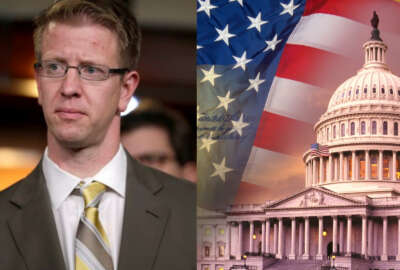Keeping the best: Tips for retaining a talented workforce
The Office of Personnel Management, as well as all other federal agencies, spend a lot of time thinking about, and working toward, recruiting and hiring new federal...
wfedstaff | June 3, 2015 8:51 am
By Meg Beasley
Federal News Radio
Agencies and the media alike devote significant time and resources talking about and attracting the next generation of federal employees. Often overlooked are today’s federal workers.
During the latest In Depth Conversation, host Francis Rose spoke with:
- Dr. Ronald Sanders, former Chief Human Capital Officer at the Office of the Director of National Intelligence; now with Booz Allen
- Linda Springer, former Director of the Office of Personnel Management; now with Ernst & Young
- Angela Bailey, Deputy Associate Director for Recruitment and Diversity at the Office of Personnel Management
Recruiting and retention are technically different ideas, but the panel agreed that agencies need to recognize that the two concepts are actually closely related.
Bailey wants to improve the hiring process by sending managers to job fairs rather than generic agency representatives.
“It makes so much more sense to send the people who the potential employee will actually be working with to make that first step, that first connection,” she says.
A key component to retaining employees is accurately selling the position and the agency culture to begin with.
Bailey says attrition within the first year is often due to employees feeling that their job or workplace environment, “was not what they signed up for.”
The Office of Personnel Management (OPM) is set to release a handbook for managers in late August called USA Jobs which will outline a module around recruiting.
Still, Bailey says “some of the best recruitment is done in real life, just talking to people about your job as the guy next door rather than someone in a top secret covert operation.”
She adds that building diverse networks and relationships in recruiting will help to break a rut of hiring people that look and act like the people already in the agency.
Diverse workplaces tend to be more productive and have higher retention rates because employees feel valued as individuals and for their skills.
Once an agency hires an employee, what are the most important factors to keeping them?
According to Sanders, retention in the federal workforce today is “awesome” with an attrition rate of between one and two percent; however, as the economy rebuilds and the government is no longer the clear employer of choice, agencies will be forced to work harder to keep their employees.
An individual’s employment decision is influenced by a matrix of tangible and intangible incentives.
Pay is the most obvious tangible, and Springer says the government’s comprehensive pay packages, especially the benefits, certainly are considered. She says, though, it is a mistake to say that people stay for the money: “I think people feel strongly about what they do. Even when there are more job choices people stay because they are passionate about public service.”
Sanders agreed, saying, “If you pick the 10 things people look for, pay is probably in the middle, intangibles come out on top. Pay is more important when there is an extreme difference with what someone could get in the private sector, but it really comes down to fairness, ‘Am I being treated fairly’. Most people come to government because of the intangible rewards of public service. I don’t think you can quantify that.”
So what are the crucial intangibles?
On-boarding is the process of helping new members of an organization integrate and become effective team members.
The panelists agreed that while it is the first stage of acclimation to a new job, on-boarding should really be a process.
Bailey says that it should be a one to two year transition of monthly, if not weekly, meetings with the new employee. Discussions could range from commonly used agency acronyms to short and long term career opportunities.
She also says that the more personal aspect of adjusting to life in a new location is overlooked.
“Our metric for successful on-boarding tends to be good performance, but you can’t get great performance if your employees are worried about finding the local dentist or how to get the kids to school. People can’t focus on work if all the little things aren’t taken care of. An ideal on-boarding will see that family life is taken care of and the individual is being taken care of at the job.”
According to Sanders, relationships with managers are essential to retaining a quality workforce.
Many employees leave because they disliked their manager, not their job.
He says that while it is hard to quantify what makes a successful manger, the kind of managerial and supervisory training being promoted by OPM Director John Berry is crucial.
“We don’t do brain surgery without a trained brain surgeon, but we often trust people to become managers without prepping them for that challenge,” says Sanders.
Springer says it is important that employees feel they have access to and can interact with other higher-ups than just their direct supervisor.
“Face time is important. We have to have an ongoing set of vehicles to allow things to surface rather than fester…it is important that people feel embraced and valued and ok expressing themselves,” she says.
Her organization does this with a series of brown bag lunches and a “my idea” email account, essentially an updated comment box.
Agencies should also monitor their departments’ pulses.
Division heads should strive to reward innovation and collaboration and watch for areas of discontent.
Sanders says internal surveys are one of the most effective ways to determine the high performing areas within an agency as well as those that are struggling. Managers should step in and reward the high performers and address problem areas before they create more serious problems.
The panelists also discuss generational issues and how managers can best handle the wide age and experience range in the federal work force that can complicate retention.
Generational differences are not a new challenge for employers, though, and Springer says the real obstacle managers face is not planning with an eye to the next generation of employees, but effectively managing the diverse mixture of Baby Boomers, Gen-Xers and Millennials who are currently in the workforce.
“When you come to understand those three, there are some very significant differences between them, and it benefits managers to have understanding of those differences to best manage them,” says Springer.
She also says managers need to acknowledge that younger generations are more likely to be comfortable with technology and develop ways to share and leverage that information.
She adds that it is important to recognize that various generations value work-life balance differently. For example, a Baby Boomer might want another assignment as a reward for a job well done while a Millennial might want time off as a reward.
Bailey says that what many people see as a generational issue she views as a personality issue. “There are some 19-year-olds that I’d just as soon work with than some 40-year-olds. And I’ve met many a spoiled brat 40-year-old, too, that have the same tendencies we claim the younger generation has. It’s more who culturally fits in, who is a good team player. . . . It’s a personality, internal drive that all generations have,” she says.
Copyright © 2024 Federal News Network. All rights reserved. This website is not intended for users located within the European Economic Area.





